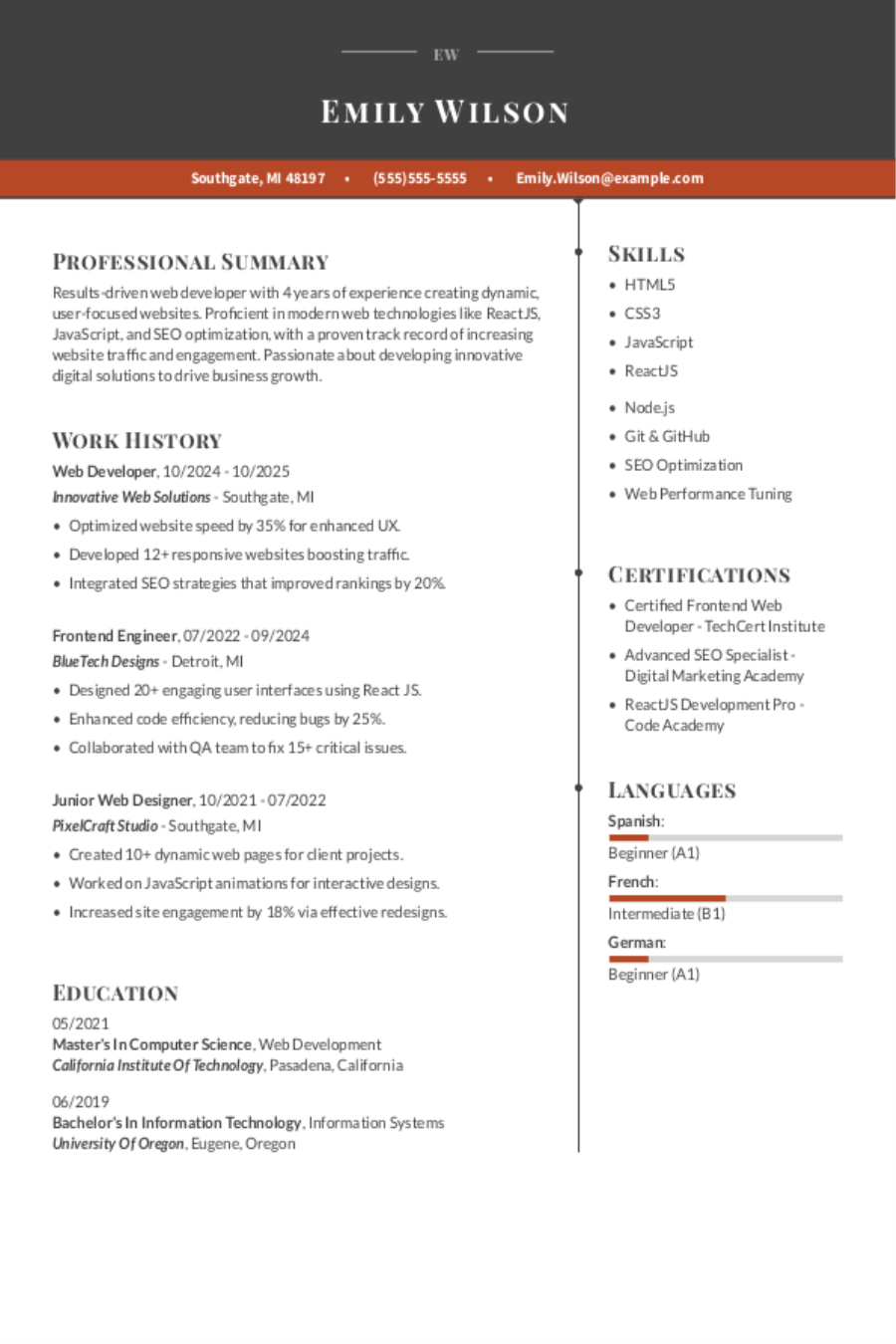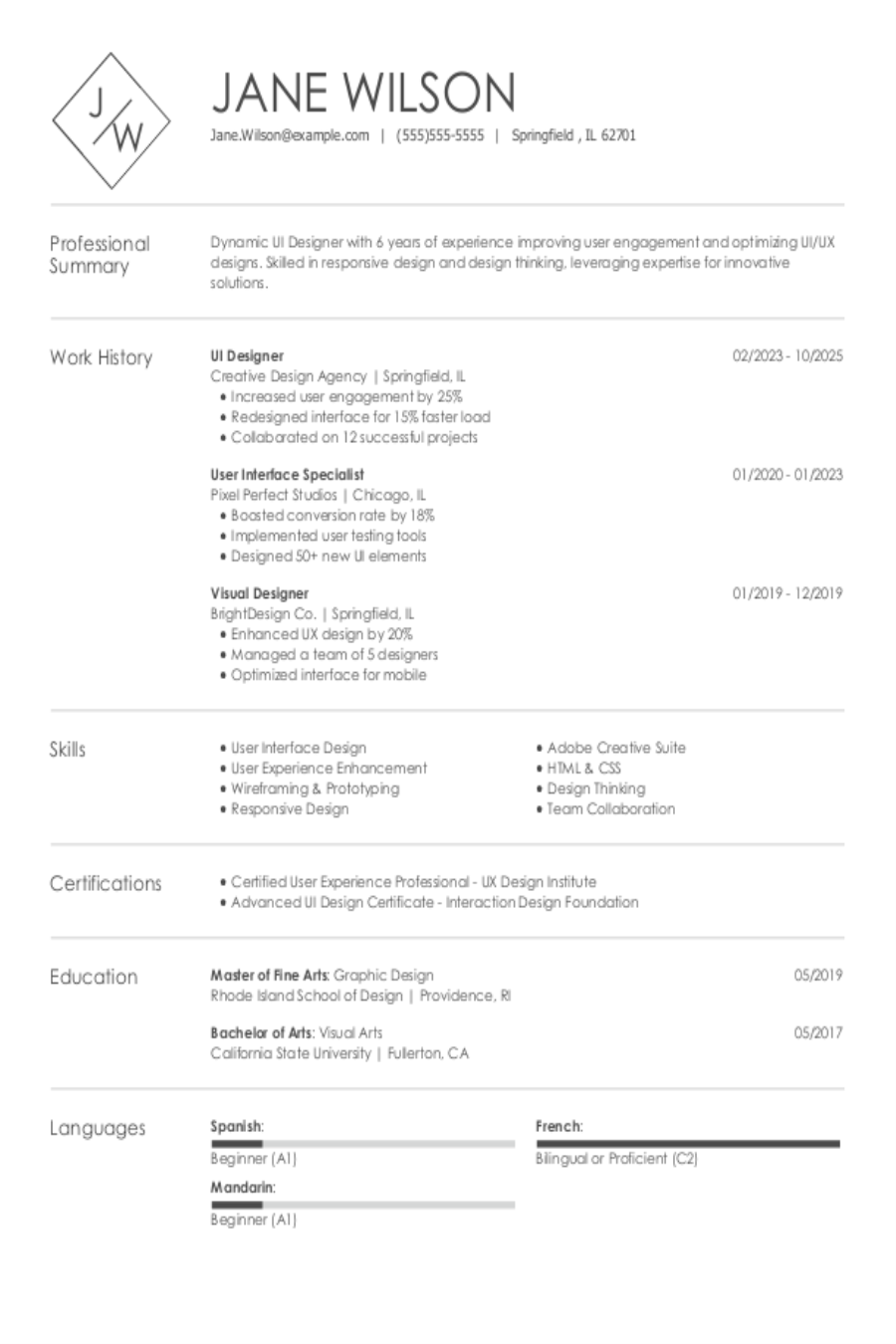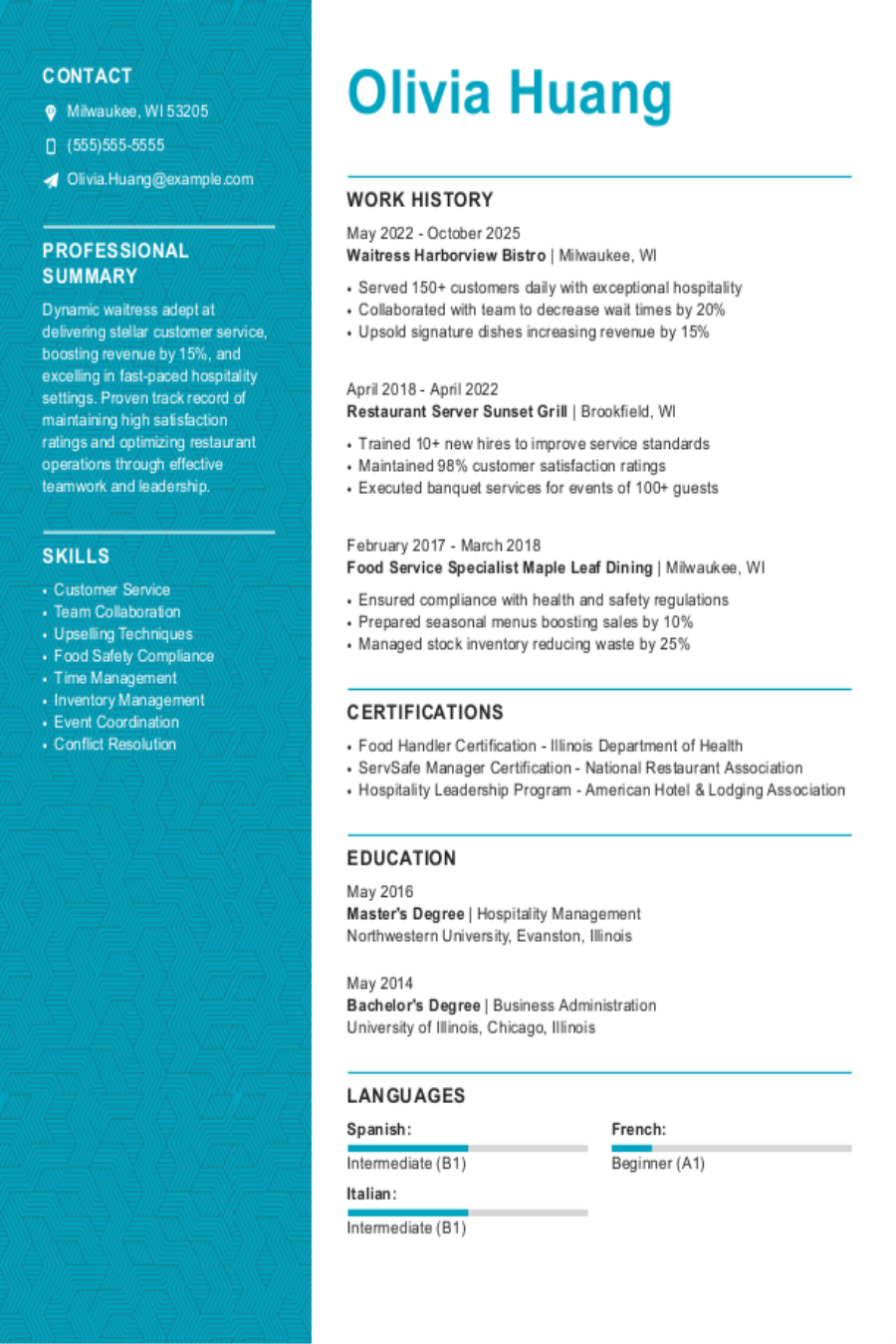Popular Art Resume Examples
Entry-level art resume
An entry-level resume for art should focus on showcasing relevant education, artistic skills, exhibitions, volunteer experiences, and any awards or recognitions to highlight creativity and potential despite limited professional background.
Leads with education: This resume focuses on education and gives the reader a sense of the candidate's expertise and knowledge of art techniques.
Emphasizes soft skills: This resume effectively highlights the applicant's soft skills in creative direction and team leadership, which compensate for limited experience.
Mid-career art resume
A mid-career artist's resume should emphasize a diverse portfolio, relevant skills, and continuous artistic development to effectively demonstrate versatility and growth in their creative journey.
Balances experience and skills: This job seeker's resume effectively combines artistic skills and leadership experience, highlighting significant achievements in brand development and project optimization while showcasing a clear trajectory of professional growth in the art industry.
Uses a neat template: A streamlined design and clear organization highlight the job seeker's accomplishments, enabling recruiters to quickly identify qualifications and relevant experience that stand out in a competitive field.
Experienced art resume
An experienced artist's resume should prioritize showcasing their creative achievements and evolution in style, ensuring a clear narrative that highlights their artistic journey and contributions to the field.
Quantifies achievements: Quantifiable achievements, such as increasing client satisfaction by 25% or managing budgets of $200K, provide clear evidence of a job seeker's impact. These measurable results help recruiters quickly grasp the value and effectiveness of an applicant's contributions in previous roles.
Embraces a modern style: This modern resume template effectively showcases the job seeker's artistic expertise and leadership, highlighting their innovative contributions to design while emphasizing a commitment to quality and client satisfaction.
No experience art resume
A resume for an applicant with no experience should highlight relevant skills, volunteer work, and any educational achievements to showcase their potential and enthusiasm for the position they are applying for.
Avoids jargon: Applicants often inflate their roles by using complex jargon, which can obscure the true impact of their work. Opting for clear, straightforward descriptions like "assisted with art workshops" or "created promotional materials" highlights genuine contributions and skills effectively.
Lists accomplishments: This resume includes an accomplishments section that includes academic achievements that boost this candidate's credibility despite limited experience.
More resume examples
Additional Guides
- Artist
- Banking
- Biotech
- Budtender
- Business
- Business Operations
- Cashier
- Chef
- Chemistry
- College
- Communications
- Computer
- Computer Science
- Construction
- Consultant
- Cook
- Customer Service
- Customer Success Manager
- Cyber Security
- Dentistry
- Driving
- ECommerce
- Engineering
- Entry Level
- Esthetician
- Executive
- Federal
- Firefighter
- Food Service
- Government
- Graduate
- Graphic Designer
- Handyman
- Healthcare Support
- High School Student
- Hospitality
- Human Resources
- Industrial Engineering
- Insurance
- Interior Design
- Internship
- IT
- Law
- Manager
- Marketing
- Medical
- Military
- Music
- Nursing
- Performing Arts
- Pharmacy Technician
- Photographer
- Physical Therapy
- Pilot
- Product Manager
- Product Owner
- Production Assistant
- Program Manager
- Project Manager
- Psychology
- Radiologic Technologist
- Real Estate
- Restaurant Manager
- Retail
- Sales
- Sales Associate
- Scholarship
- Server
- Skilled Trades
- Social Services
- Software Engineer
- Stay At Home Mom
- Student
- Supervisor
- Teacher
- Teen
- Training Development
- Ux Designer
- Virtual Assistant
- Waitress
Art Resume Template
Looking to showcase your creativity? Start with this versatile art resume template, ready for you to personalize and make your own with just a few simple tweaks.
Emily Johnson
Cincinnati, OH 45206
(555)555-5555
Emily.Johnson@example.com
Professional Summary
Dynamic Art Director with 5 years of success in impactful design, brand development, and creative direction, seeking to elevate artistic initiatives through innovative solutions.
Work History
Art Director
Visionary Arts Studio - Cincinnati, OH
June 2023 - September 2025
- Boosted client satisfaction by 30%
- Spearheaded rebranding for 5 major clients
- Implemented 20% cost reduction strategies
Creative Designer
Innovative Creations Inc. - Cincinnati, OH
June 2021 - May 2023
- Streamlined design processes by 40%
- Led team to increase productivity by 25%
- Designed 50+ successful ad campaigns
Graphic Artist
Imagination Unlimited - Columbus, OH
September 2020 - May 2021
- Enhanced digital presence by 15%
- Collaborated on projects raising sales 20%
- Managed portfolio of 100+ designs
Skills
- Creative direction
- Graphic design
- Project management
- Brand development
- Digital illustration
- Adobe Creative Suite
- User-centered design
- Visual storytelling
Education
Master of Fine Arts Visual Arts
University of Arts New York, New York
August 2020
Bachelor of Arts Graphic Design
Boston University Boston, Massachusetts
May 2018
Certifications
- Certified Design Professional - Design Institute of America
- Adobe Creative Certification - Adobe Systems
Languages
- Spanish - Intermediate (B1)
- French - Beginner (A1)
- Italian - Beginner (A1)
Writing Your Art Resume
Having explored some impressive resume examples, you're now prepared to dive into the comprehensive process of writing your own. We will guide you step by step through each section, ensuring you understand how to write a resume that effectively showcases your skills and experiences.
List your most relevant skills
An effective skills section on your art resume is important for showcasing your qualifications. You want to highlight both technical abilities, such as skill with various mediums or software, and soft skills like creativity and collaboration.
To make your skills section stand out, carefully read job listings for keywords from the job listing that resonate with the position you’re pursuing. By incorporating these keywords into your resume, you not only appeal to human recruiters looking for a good fit but also improve your chances of passing through applicant tracking systems (ATS).
Example of skills on an art resume
- Proficient in various artistic techniques including painting, sculpture, and digital media
- Experienced in curating exhibitions and designing engaging displays
- Innovative thinker with a collaborative approach to project development
- Careful attention to detail with strong skills in art restoration and preservation
A well-crafted skills section is essential for showcasing your readiness for the job. It's important to include both the technical skills mentioned in the job description and relevant soft skills. This combination not only highlights your qualifications but also demonstrates your ability to adapt and thrive in the role, making you a standout job seeker.
Highlight your work history
Creating an effective work experience section is important for your art resume. This part should highlight not just your roles but also your achievements, showcasing how you've applied your artistic skills in various projects. Use specific examples to demonstrate your creativity and contributions, making sure to include relevant keywords that resonate with potential employers in the art industry.
For each job entry, be sure to include essential details such as your title, the name of the gallery or institution, and the dates you worked there. This information helps establish your credibility and gives employers a quick overview of your professional background.
Example of an art work experience entry
- Creative Strategist
Creative Design Studio - New York, NY
June 2018 - Present - Lead a team of 10 designers in creating innovative visual concepts for diverse projects, achieving a 30% increase in client satisfaction and retention rate
- Develop and execute strategic design plans that align with client branding and marketing objectives, resulting in a 20% growth in project deliverables efficiency
- Collaborate with cross-functional teams to ensure seamless integration of creative vision into multi-channel campaigns, improving brand consistency across platforms by 15%
- Mentor junior designers through one-on-one coaching sessions, improving their skills and productivity by 25% within the first year of onboarding
- Spearhead the adoption of new design technologies and tools, reducing production time by 40% while maintaining high-quality standards
Aim for clarity in your resume bullet points by focusing on specific achievements. Use concise language to highlight key outcomes, ensuring each point conveys value without unnecessary detail. This balance will make your experience stand out effectively.
Add portfolio work to your resume
For art professionals, your resume must not only highlight your skills but also entice hiring managers to explore your full portfolio. The challenge lies in showcasing your artistic achievements while inviting employers to see the breadth of your work.
Begin by placing a link to your online portfolio prominently at the top of your resume, right under your contact details. Create a brief section titled "Portfolio Highlights" where you can list 3-4 key projects with engaging descriptions.
Example of a portfolio highlights section
- Mural Creation for City Youth Center – Designed and painted an engaging mural that fostered community pride and received local media coverage
- Illustration Series for Eco-Friendly Magazine – Developed a series of illustrations that increased reader engagement by 50%
- Photography Exhibition at Local Gallery – Curated and showcased a collection of landscape photographs, attracting over 200 visitors in the first week
- Logo Design for Green Leaf Organics – Crafted a distinctive logo that improved brand recognition and was featured in regional marketing materials
Include your education
The education section of your art resume should be structured to highlight your academic credentials in reverse-chronological order, beginning with the most recent degree. Include any diplomas, degrees, and certifications relevant to the field of art, while omitting high school diplomas if you hold a higher education qualification.
For those currently pursuing an artistic degree or with incomplete education, it’s important to list the highest level completed along with an expected graduation date. You can improve this part by including bullet points that detail relevant coursework or specific projects that showcase your skills and creativity. This approach is particularly helpful for students or recent graduates.
Common certifications for an art resume
- Certified Artist (CA) – National Association of Professional Artists (NAPA)
- Professional Visual Artist (PVA) – American Society of Artists (ASA)
- Master Painter Certification (MPC) – International Institute of Art and Design (IIAD)
- Digital Art Specialist (DAS) – Digital Arts Guild (DAG)
Sum up your resume with an introduction
Creating a strong profile section on your paralegal resume is important, as it serves as your first opportunity to make an impression on potential employers. This introductory segment allows you to briefly highlight your qualifications and set the tone for the rest of your application.
If you’re an experienced paralegal, consider using a professional summary that succinctly showcases your key accomplishments and areas of expertise. By placing this at the top of your resume, you enable recruiters to quickly assess what you bring to the table. Alternatively, inexperienced candidates should write a resume objective that focuses on their career development and goals.
Professional summary example
Dynamic artist with over 10 years of experience in diverse creative projects, specializing in visual storytelling and innovative design solutions. Demonstrated success in improving brand identity through compelling artwork and engaging multimedia campaigns. Proficient in various artistic techniques, including digital illustration and mixed media, while consistently delivering high-quality results that resonate with audiences.
Resume objective example
Enthusiastic artist eager to apply a unique mix of creativity and technical skills to improve a dynamic art team. Seeking to use strong communication, adaptability, and attention to detail to contribute innovative ideas and support collaborative projects that drive artistic excellence.
Incorporating keywords into your resume profile is important for standing out, especially when you are applying for an art position. Begin by analyzing the job description to identify key terms and qualifications. Seamlessly weave these keywords into your introduction, which improves your chances of passing through ATS systems and catching the attention of potential employers.
Add unique sections to set you apart
Optional resume sections for art positions allow you to highlight your unique qualifications and set yourself apart from other job seekers. These sections are a great opportunity to showcase what makes you an individual artist, beyond just your work experience.
By including relevant hobbies or volunteer experiences, you can reveal different aspects of your professional life that reflect your values and skills. For instance, if you regularly engage in community art projects or teach workshops, these activities demonstrate not only your passion for art but also your commitment to sharing knowledge and engaging with others.
Three sections perfect for a art resume
- Work Samples: Including a portfolio section in your creative resume is essential for showcasing your artistic talents. Present 3-5 notable works, detailing the inspiration behind each piece and your unique approach to overcome challenges, allowing employers to appreciate your creativity and skills.
- Client Testimonials: Incorporating client testimonials into your resume can significantly improve your appeal in the creative field. Select effective quotes that showcase your unique skills and successful collaborations, demonstrating to potential employers how you’ve made a difference for others.
- Awards and Recognition: Including awards on your resume can improve your appeal to employers. Highlight relevant accolades, such as art exhibitions or scholarships, along with the issuing organization and date, to showcase your achievements and dedication to your craft.
5 Resume Formatting Tips
- Choose a format that matches your career stage.
Choosing the right resume format is important based on your career level and experience. If you're an experienced professional, a chronological format effectively showcases your career progression. For those just starting out, a functional resume highlights your skills over job history. Alternatively, if you want to emphasize both experience and skills, consider a combination resume for a well-rounded presentation of your qualifications.
- Pick a smart resume template.
Using a professional resume template is essential for improving readability and ensuring your formatting looks polished. A well-designed template allows your key information to stand out at a glance. If you opt for a custom layout, focus on clarity and select fonts that are easily readable by applicant tracking systems (ATS) to boost your chances of getting noticed.
- Select an appropriate font.
Selecting a professional font is important for ensuring your resume is easily readable. Opt for classic fonts such as Helvetica, Georgia, or Garamond. These choices improve clarity and professionalism, making a positive impression on both applicant tracking systems and hiring managers.
- Use consistent formatting.
Ensure your resume is neatly aligned with uniform margins, improving readability and presenting a polished image to potential employers.
- Keep your resume to one or two pages.
When crafting your resume, remember that resumes should be one page long unless you have extensive experience. Focus on making every word count by highlighting key achievements and skills, ensuring clarity and brevity throughout the document.
Tools for Your Job Search
Are you ready to showcase your artistic talents in your next job application? Before you hit send, consider using our ATS Resume Checker. This tool provides insights on how well your resume is likely to perform with the automated systems that creative organizations use for initial screenings.
Looking to elevate your resume even further? With our AI Resume Builder, you can access tailored recommendations specific to the art field. It also offers professionally designed templates that emphasize your unique skills and experiences, helping ensure your creativity catches the attention of potential employers.
Frequently Asked Questions
Last Updated: September 18, 2025
Absolutely. A cover letter is important as it enriches your resume and establishes a personal connection with potential employers. It provides you with an opportunity to express your passion for the art role and demonstrate how your background aligns with their needs. Don't hesitate—write a cover letter that highlights your unique qualifications.
For a quick and efficient way to create your cover letter, try our AI Cover Letter Generator. It allows you to generate tailored content in just minutes, complete with various cover letter template options that perfectly match your resume design. This ensures your application stands out while conveying your artistic vision effectively.
A resume is generally a concise document, spanning one to two pages, that highlights your key skills and experiences. In contrast, a CV (curriculum vitae) can be several pages long and provides an in-depth look at your academic background, research contributions, publications, and professional history.
You should use a CV when applying for positions in academia or specialized fields such as law or medicine. If you need to create a tailored CV quickly and effectively, our online CV Maker is the perfect solution. Choose from our diverse range of CV templates designed for various industries and career levels to get started on crafting your standout application.
An engaging LinkedIn profile is important for artists seeking new opportunities. It allows you to connect with fellow creatives, showcase your portfolio, and highlight your unique skills, ultimately improving your visibility in the art community.
Many artists start as assistants or interns, developing their skills and portfolio. Through experience, advanced training, or specialized courses, they can progress to senior artist roles or even become art directors in creative industries.
To stay competitive in the art field, consider attending workshops and exhibitions to connect with peers and discover new techniques. Joining artist collectives can provide networking opportunities. Additionally, subscribing to art journals and participating in online courses can improve your skills and keep you informed about emerging trends.
As an art professional, showcasing your dedication to continuous development is vital. Consider obtaining relevant certifications and listing any completed courses or seminars you've attended. Engaging with industry literature, listening to insightful podcasts, and maintaining memberships in professional associations also reflect your commitment to staying informed about current trends and techniques in the field. These actions serve as tangible proof of your proactive approach to professional growth.
Was this information helpful? Let us know!
Leisha is a career industry editor dedicated to helping job seekers excel in their careers.
More resources

How to Include Networking Skills on a Resume (40+ Examples, Definition & Tips to Improve)
What are networking skills? We ll answer this and all your p...

RoboBossing: 66% of Workers Say AI in Leadership Would Make the Workplace More Fair and Efficient
Resume Now s latest report finds growing support for thoughtfu...

How to Write a Resume for a Career Change
Need a resume to showcase your unique career path? Our guide c...

Web Developer Resume: Examples, Templates & Tips for 2025
Was this information helpful? Let us know ...



